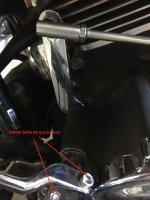Mad Mike
Well-known member
I’m seeing a new thread coming in a few weeks titled “How do I remove a bolt that had Red Loctite?”I ordered the part, will take a couple of weeks to come in.
My JB weld and red loctite has so far secured it well, actually better then it was ever. Might have been an issue all along. Went for a longer ride yesterday and no issues. no extra play.
Thanks again everyone for the suggestions, info etc. GTAM always comes through.
Red is used for permanent locking, or for nut/bolts over 1/2” when used on chassis parts. The bolt will likely snap when you try to remove, hopefully your bolt is threaded into a nut and not into the shifter arm.
I prefer nylon or stover bolts for nut and bolt fastening, and blue loctite for studs.















